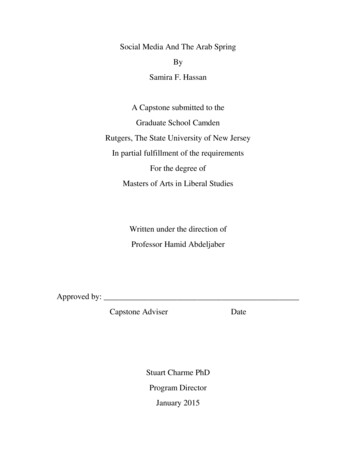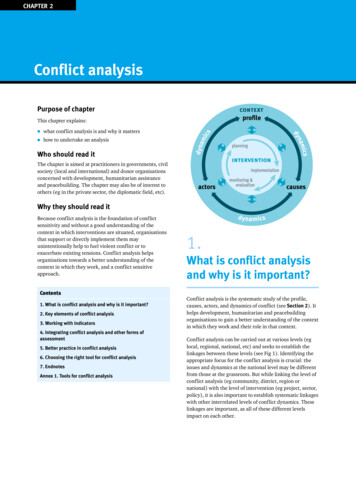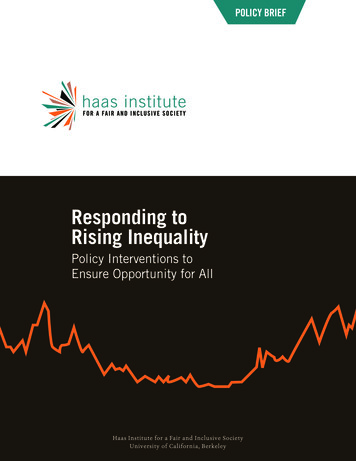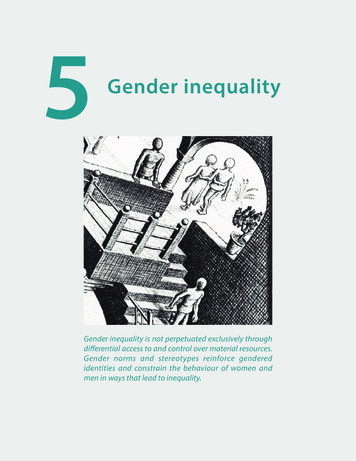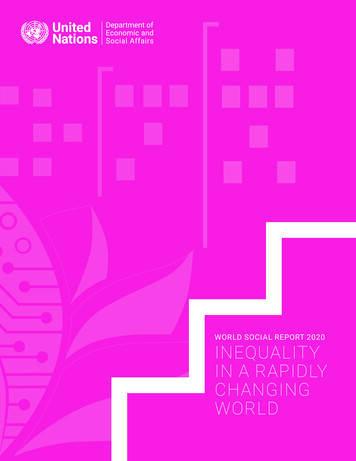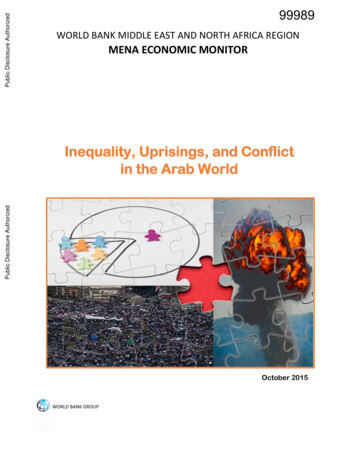
Transcription
Public Disclosure AuthorizedWORLD BANK MIDDLE EAST AND NORTH AFRICA REGIONMENA ECONOMIC MONITORInequality, Uprisings, and Conflictin the Arab WorldPublic Disclosure AuthorizedPublic Disclosure AuthorizedPublic Disclosure Authorized99989October 2015WORLD BANK GROUP
WORLD BANK MIDDLE EAST AND NORTH AFRICA REGIONMENA ECONOMIC MONITORInequality, Uprisings, and Conflictin the Arab World
2015 International Bank for Reconstruction and Development / The World Bank1818 H Street NW, Washington DC 20433Telephone: 202-473-1000; Internet: www.worldbank.orgSome rights reserved1 2 3 4 17 16 15This work is a product of the staff of The World Bank with external contributions. The findings, interpretations, andconclusions expressed in this work do not necessarily reflect the views of The World Bank, its Board of ExecutiveDirectors, or the governments they represent. The World Bank does not guarantee the accuracy of the data includedin this work. The boundaries, colors, denominations, and other information shown on any map in this work do notimply any judgment on the part of The World Bank concerning the legal status of any territory or the endorsementor acceptance of such boundaries.Nothing herein shall constitute or be considered to be a limitation upon or waiver of the privileges and immunities ofThe World Bank, all of which are specifically reserved.Rights and PermissionsThis work is available under the Creative Commons Attribution 3.0 IGO license (CC BY 3.0 . Under the Creative Commons Attribution license, you are free tocopy, distribute, transmit, and adapt this work, including for commercial purposes, under the following conditions:Attribution—Please cite the work as follows: Elena Ianchovichina, Lili Mottaghi, and Shantayanan Devarajan,2015 “Inequality, Uprisings, and Conflict in the Arab World” Middle East and North Africa Economic Monitor,(October), World Bank, Washington, DC. Doi: 10.1596/978-1-4648-0735-0 License: Creative Commons AttributionCC BY 3.0 IGOTranslations—If you create a translation of this work, please add the following disclaimer along with theattribution: This translation was not created by The World Bank and should not be considered an official WorldBank translation. The World Bank shall not be liable for any content or error in this translation.Adaptations—If you create an adaptation of this work, please add the following disclaimer along with theattribution: This is an adaptation of an original work by The World Bank. Responsibility for the views and opinionsexpressed in the adaptation rests solely with the author or authors of the adaptation and are not endorsed by TheWorld Bank.Third-party content—The World Bank does not necessarily own each component of the content contained withinthe work. The World Bank therefore does not warrant that the use of any third-party-owned individual component orpart contained in the work will not infringe on the rights of those third parties. The risk of claims resulting from suchinfringement rests solely with you. If you wish to re-use a component of the work, it is your responsibility todetermine whether permission is needed for that re-use and to obtain permission from the copyright owner.Examples of components can include, but are not limited to, tables, figures, or images.All queries on rights and licenses should be addressed to the Publishing and Knowledge Division, The World Bank,1818 H Street NW, Washington, DC 20433, USA; fax: 202-522-2625; e-mail: pubrights@worldbank.org.ISBN (electronic): 978-1-4648-0735-0DOI: 10.1596/978-1-4648-0735-0Cover photo: ISTOCK
WORLD BANK MIDDLE EAST AND NORTH AFRICA REGIONMENA ECONOMIC MONITORInequality, Uprisings, and Conflictin the Arab WorldACKNOWLEDGEMENTSThe MENA Economic Monitor is a product of the Office of the Chief Economist of the Middle East andNorth Africa Region of the World Bank. Part I of the report discusses the short-term, global and regionalmacroeconomic outlook. Part II focuses on the relationships between inequality, uprisings, and conflict inthe Arab World. Part III of the report contains country notes. The report was prepared under the guidanceof Shantayanan Devarajan, Chief Economist, Middle East and North Africa Region of the World Bank.Part I was written by Lili Mottaghi with inputs prepared by country economists. We are grateful toFranziska Lieselotte Ohnsorge, Dana Lauren Vorisek, and Elena Ianchovichina for helpful comments.Part II of the report was led and written by Elena Ianchovichina with inputs prepared by Martijn Burger,Nadia Hassine, Roy van der Weide, Christoph Lakner, Youssouf Kiendrebeogo, Efstratia Arampatzi,Suleiman Abu Bader, Caroline Witte, Niels Johannesen, and Stylianos Michalopoulos. We receivedvaluable comments on the background papers and notes for this part of the report in a workshop on theArab Inequality Puzzle, organized by the World Bank’s MENA Chief Economist Office on April 27, 2015 inWashington DC. We are grateful to the workshop participants, especially Francisco Ferreira, MartinRavallion, Marcelo Giugale, Ana Revenga, Ravi Kanbur, Peter Lanjouw, Caroline Freund, Branko Milanovic,Quy-Toan Do, Martin Rama, Carol Graham, Paolo Verme, Sami Bibi, Hadi Esfahani, and Hai-Anh Dang.Finally, we received useful comments on drafts of the paper from Tara Vishwanath, Najy Benhassine,Deborah Wetzel, and Gabriel Ibarra.The third part of the report was prepared by Farrukh Iqbal based on reports by the following countryeconomists, led by Auguste Tano Kouame: Ibrahim Al-Ghelaiqah, Dalia Al Kadi, Sara Alnashar, Jean-LucBernasconi, Jose Lopez Calix, Jean-Pierre Chauffour, Khalid El Massnaoui, Shahrzad Mobasher Fard, LeaHakim, Wissam Harake, Sahar Sajjad Hussain, Nour Jalal Nasser Eddin, Ahmed Kouchouk, Sibel Kulaksiz,Thomas Laursen, Raj Nallari, and Abdoulaye Sy.Isabelle Chaal-Dabi provided excellent administrative assistance and Mark Volk designed the report’scover page.
TABLE OF CONTENTSRECENT ECONOMIC DEVELOPMENTS AND PROSPECTS . 1The Global Outlook . 1The Outlook for the Middle East and North Africa . 3INEQUALITY, UPRISINGS, AND CONFLICT IN THE ARAB WORLD . 11Introduction . 11Is Economic Inequality in Arab Countries High? . 13Plummeting Perceptions of Wellbeing in the Wake of the Arab Spring . 21Grievances, Divisions, and Implications . 29COUNTRY NOTES . 37REFERENCES. 56BOXESBox 1.1The Impact of Emerging Markets Turmoil on the MENA Countries . 8FIGURESFigure 1.1Figure 1.2Figure 1.3Figure 1.4Figure 1.5Figure 1.6Figure 2.1Figure 2.2Figure 2.3Figure 2.4Figure 2.5Figure 2.6Figure 2.7Figure 2.8Figure 2.9Figure 2.10Figure 2.11Figure 2.12Figure 2.13Figure 2.14Figure 2.15Figure 2.16Figure 2.17Figure 2.18Recent Developments in the Global Economy . 1Greenfield Investment Globally . 2Fiscal and External Balances . 3Economic Situation in Developing Oil Exporters . 4Economic Situation in Oil Importers . 5MENA’s Fiscal and External Positions . 7Poverty Rates and Expenditure Growth of the Bottom 40 percent . 12Inequality – Over Time and Across the World . 12Arab Region’s Development Context . 15Comparisons of Expenditure Inequality in MENA. 16Wealth Concentrated in the Hands of Billionaires. 18Hidden Bank Deposits . 20Reality vs. Perceptions in Egypt (Percent by Decile) . 22Average Life Satisfaction by Country (2006-2012) . 23Average Income and Subjective Wellbeing by Country (2008-2011). 24Economic Growth and Change in Subjective Wellbeing . 25Change in Life Satisfaction, 2009-10 . 26Evolution of Life Satisfaction during the Second Half of the 2000s . 26Effects of Different Domains on Life Satisfaction in the Arab World . 27Main Reasons for the Arab Spring Uprisings . 27Dissatisfaction with Government Services (Percent Dissatisfied) . 28Change in Life Satisfaction of the Top 60 Percent Relative to the Bottom 40 Percent,2009-10 . 29Decomposition of Expenditure Inequality by Household Attributes . 31Ethnic Inequality and Spatial Inequality . 33TABLESTable 1.1Table 2.1Table 2.2Appendix Table 2.1Macroeconomic Outlook . 9Inequality Measures for Urban Egypt Corrected for Missing Top Incomes. 17Correlation between the Ratio of Haven Deposits to GDP and the Gini Coefficient . 20Poverty Statistics . 38
RECENT ECONOMIC DEVELOPMENTS AND PROSPECTSThe Global OutlookOver the last three months, global markets have been unusually volatile. Commodity prices havebeen under downward pressure with indices of agriculture, metals and energy all declining andoil prices falling below 46 per barrel in August, their lowest level since 2008. Volatility incurrencies and stocks increased significantly in July and August following a 40 percent correctionin China’s stock market from its June high, along with an unexpected depreciation of China’scurrency, the renminbi, in August. Combined with uncertainty about the timing of a U.S. FederalReserve interest rate hike, the commodity price weakness and correction in Chinese stock pricessparked a sharp sell-off across emerging market currencies and equities. Developing countryborrowing costs rose in line with higher risk-aversion, with the Emerging Market Bond Index(EMBI) spread increasing by 23 basis points between end-July and mid-September (Figure 1.1,left panel). Outflows from emerging-market bond and equity funds were significant in August;the pace appears to have slowed in September.Figure 1.1 Recent developments in the global economyEMBI, basis pointTaper tantrumReal GDP growth, percentOil price -6Jan. 13Sept. 15ChinaIndiaJapanUnited United SouthStates Kingdom AfricaEuroAreaBrazilRussiaSource: World Bank.Recent data show that global growth struggled to gather momentum in the second quarter of2015, with activity in the Euro Area and Japan slowing, growth in China continuing to decelerate,the economies of Russia and Brazil contracting and those of other major commodity exportersweakening (Figure 1.1, right panel). Looking forward, PMI surveys are still firmly in expansionaryMENA Economic MonitorOctober 20151
territory in high-income countries, but point to contraction in developing countries. In June, theWorld Bank predicted global GDP growth of 2.8 percent in 2015, slightly up from 2.6 percent in2014. Against the backdrop of disappointing data outcomes and turbulence in global financialmarkets, even the modest pick-up in global growth anticipated in June for the year 2015 will likelynot materialize.Global inflation remains low, reflecting the continued dampening effect of low commodity prices,sluggish wage growth in advanced economies, and overcapacity in China. Nevertheless, inflationincreased in a number of large emerging markets this year particularly Brazil, Russia, Indonesia,Malaysia, Colombia, Chile, Turkey, South Africa, and Egypt. This was mostly a result of significantcurrency depreciations, and to a lesser extent, increases in administrative prices and indirecttaxes.Following slower growth in the emerging economies, global trade witnessed a slowdown of about4 percent in the first half of 2015 compared with the second half of 2014. The fall, the first since2009, was driven by a significant contraction in import demand from emerging markets, includingthose in Asia and Central and Eastern Europe.In addition, lower commodity prices and the turmoil in the Middle East together withexpectations of the U.S. interest rate hike have significantly slowed greenfield capital flows todeveloping countries. According to estimates from fDi Markets, greenfield investments in a largenumber of countries, mostly the emerging markets, declined dramatically in the first six monthsof 2015 compared to the same period of last year (Figure 1.2).Figure 1.2 Greenfield investment globallyTurkey OmanSaudiRussia ArabiaBrazilIraqRepublicofTunisia Jordan Lebanon Yemen Congo0-10-20-30-40-50-60-70-80% change in FDI inflows, H1 2015compared to H1 2014-90-100Source: fDi MarketsMENA Economic MonitorOctober 20152
The Outlook for the Middle East and North AfricaAgainst this backdrop of a slowing global economy, the MENA region is stagnating. Continuedlow oil prices, the escalation of conflicts, and civil wars make the short-term prospects for agrowth recovery slim. The World Bank estimates regional GDP growth to stay at around 2.8percent in 2015, lower than predicted in April. While growth is slightly higher than last year,overall growth in the region has not exceeded three percent for over three years (Table 1.1). Ina positive scenario of decreasing tensions in Libya, Iraq, and Syria, together with recovery in theEuro area that could boost external demand, growth in the region could rebound to 4.4 percentin 2016 and the following year. However, if current circumstances persist, overall growth is notexpected to recover any time soon.Except for Egypt, Morocco and Iran, almost all MENA countries are growing slowly, but fordifferent reasons. The GCC and Algeria are suffering from low oil prices and the lack of fiscaladjustment. GCC economies are expected to grow at 3.2 percent in 2015, down from 3.9 percenta year earlier as low oil prices have severely hit these economies. For the same reasons, growthin Algeria is expected to remain at 2.8 percent in 2015.Fiscal positions in oil exporters are worsening. A surplus of about 5.4 percent of GDP in 2013 isexpected to turn into a deficit of about 9.8 percent of GDP in 2015 in the GCC countries and evenhigher in Algeria. For the Gulf States, this means a deficit of US 136 billion in 2015 with SaudiArabia bearing about US 129 billion (or a deficit of 19.5 percent of GDP in 2015); surpluses inKuwait and Qatar are expected to halve in 2015 (Figure 1.3a). Current account balances willfollow the same pattern and surpluses are expected to shrink rapidly in 2015 (Figure 1.3b).Figure 1.3 Fiscal and external balances40301.3a. Fiscal balance, percent of GDP201320142016p2017p2015e20401.3b. Current account balancepercent of hrain Kuwait Oman Qatar Saudi UAE AlgeriaArabiaBahrain Kuwait Oman Qatar Saudi UAE AlgeriaArabiaSource: World Bank. e stands for estimate and p for projection.MENA Economic MonitorOctober 20153
Although some countries, particularly Saudi Arabia and UAE, have started rethinking their hugespending on subsidies, the macroeconomic imbalances will likely spillover to 2016 and thefollowing year if oil prices remain at their low levels and governments maintain their currentspending scheme.MENA’s developing oil exporters (except for Algeria and Iran post sanctions) are facing a doublehit of low oil prices and civil war (Mottaghi, 2015). The escalation of conflict and sabotage of oilfields in the majority of developing oil exporters are expected to keep the average growth rateat a low level. Conflicts in Libya, Yemen, Iraq and Syria have severely hurt these economies (Figure1.4).Figure 1.4 Economic situation in developing oil exportersFiscal balance, percent of GDPCummulative loss of real GDP, byaSyria201320142015e2016p2017pSource: World Bank. e stands for estimate and p stands for projection.The majority of the developing oil exporters saw a decline of about 40 percent or more in theiroutput, with significant damage to their oil sectors and a fall in oil production (estimates forYemen are not available). Conflict has escalated in Yemen resulting in a catastrophichumanitarian emergency, massive displacement of people, and severe destruction of civilian andpublic infrastructures. The Syrian war and regional conflicts have displaced more than 11 millionpeople, 7.6 million internally and 4.1 million as refugees to neighboring countries. In addition tothe domestic impact of conflicts, bordering countries such as Lebanon and Jordan have beenexperiencing a slowdown in growth and a worsening fiscal stance mostly as a result of increasedspending on hosting refugees and disruptions in trade (see below). Overall growth for the groupof developing oil exporters is expected to reach 1.3 percent in 2015, slightly higher than last year,mainly due to a likely slow recovery in Libya and Iraq.MENA Economic MonitorOctober 20154
The Iranian economy is expected to recover and grow faster in 2016 and beyond following thenuclear deal reached on July 14, 2015. With the lifting of sanctions and Iran’s reintegration intothe global economy, an additional 1 million barrels a day of crude oil will eventually hit theinternational oil market, lowering oil prices by an estimated 13 percent (Ianchovichina,Devarajan, Lakatos, 2015). This would negatively affect the already weak economies of oilexporters but to a lesser degree Iran. The additional oil production could boost growth in theIranian economy outweighing the negative impacts of falling oil prices (Devarajan, Mottaghi,2015).Both the fiscal position and external balances of this group of developing oil exporters is expectedto worsen in 2015 to the tune of deficits of 10.3 and 8.4 percent of GDP respectively. Libya standsout with a fiscal deficit of over 55 percent of GDP and current account deficit of 70 percent ofGDP in 2015 (Table 1.1). Wages and salaries in Libya account for 60 percent and subsidies for aquarter of total government spending. In a scenario where conflicts subside and oil pricesrecover, these countries may see improvements in their fiscal and external balances in 2016 andbeyond.MENA’s oil importers are being hurt by terrorist attacks, spillovers from neighboring wars, slowgrowth in the Euro zone and political uncertainty. Security tensions and sluggish external demandhave weighed heavily on economic activity in the majority of the oil importers in the MENAregion. Foreign investment and tourism have suffered (Figure 1.5).Figure 1.5 Economic situation in oil importers20Real GDP growth, percent515Percentage change in tourist arrivalsover the same period of last year1043502-5-101North AfricaOil Importers-1514Q114Q214Q314Q42015 YTD0201320142015e2016p2017pSource: World Bank and UNWTO. YTD stands for year to date; e stands for estimate and p stands for projection.MENA Economic MonitorOctober 20155
As a result of two terrorist attacks and protracted stagnation in the Euro area, the Tunisianeconomy is expected to slow down in 2015. Real GDP growth is projected to drop to 0.8 percent,from 2.3 percent last year, with further downside risk for 2015. The Palestinian economy isrecovering from a recession following last year’s war in Gaza. The economies of Lebanon andJordan are estimated to slow down due to the spillovers from the conflicts in Syria and Iraq andlack of investment. The number of refugees entering these two countries have been on the rise,reaching 1.1 and 0.6 million in September in Lebanon and Jordan respectively, squeezing theiralready tight fiscal space.Only two countries, Egypt and Morocco, may experience a growth recovery in 2015 but risks arestill on the downside. In the wake of corruption charges against some ministers, Egypt’s cabinetresigned in early September. The new government, appointed in late September, may changeagain following parliamentary elections. Under the scenario of reinforced security and reforms,growth in Egypt is expected to hover around 4 percent in 2015 and the following year. Morocco’seconomy is heavily agriculture-based and growth could swing up or down depending on weatherconditions.A further drop in oil prices coupled with current fiscal spending schemes could keep the MENAregion on the edge. Some of the oil exporters in the region have been tapping into their reservesand Sovereign Wealth Funds (SWF) to cushion the impact of low oil prices. In Libya, foreignreserves are expected to drop by 50 percent in 2015, reaching about US 50 billion comparedwith more than US 100 billion two years ago. In Saudi Arabia, a reduction in foreign reserves ofmore than US 60 billion this year and another US 80 billion next year is expected. But even thosewith significant reserves have seen new exploration projects and drilling halted. In January, forexample, Royal Dutch Shell halted its Al-Karaana petrochemicals project in Qatar due to fallingoil prices. This situation, if not reversed, will eventually hurt the MENA economies by loweringtheir ability to invest domestically and elsewhere in the region.MENA’s investment needs are high and the shortage of foreign capital have made the situationeven worse. There are estimates that Egypt needs an additional US 30-35 billion in investmentand another US 10 billion in infrastructure development over the coming years, but little hasbeen pledged. Jordan needs over US 6 billion in investment per year to put the economy on ahigher growth path and Tunisia is expecting to increase investment by an additional 7 percentagepoints of GDP over the next 5 years. Iran post sanctions needs hundreds of billions dollars toupgrade its oil fields to bring production back to pre-sanctions levels.All of the developing countries in the region are in need of financing. Cheap oil and lack of fiscaladjustments have severely deteriorated MENA’s fiscal space. An overall fiscal surplus of about 2percent of GDP in 2013 is expected to turn into a deficit of 9.2 percent of GDP in 2015 for MENAas a whole. This is the result of a sharp increase in fiscal deficits in oil exporters, dominated byMENA Economic MonitorOctober 20156
the GCC countries (Figure 1.6a). By the same token, MENA’s external account surplus of the pasttwo years is expected to turn into a deficit of about 2.6 percent of GDP in 2015 (Figure 1.6b). Themain reasons are falling oil prices which started in 2014 and reduced the surplus in the group ofoil exporters by 50 percent (see Box 1.1), and weak economic recovery in the Euro area, whichhas reduced external demand for oil and non-oil exports. If oil prices rebound and externaldemand for exports recover, MENA’s external position could improve in 2017.In sum, since the Arab Spring of 2011, the MENA region has seen a slowdown in growth, anescalation of violent conflict and civil war and, more recently, substantial fiscal pressure fromlower oil prices. In the next section, we explore how the region got to this state. In particular,we examine whether inequality or other factors contributed to the uprisings of 2010-11, as wellas to the ensuing conflicts that have spread to many parts of the region.Figure 1.6 MENA’s fiscal and external positions1.6a. Fiscal balance, percent of GDP151.6b. Current account balance, percent of GDP25201015510500-5-5-10-10MENA2013Developing Oil 13Developing Oil : World Bank.MENA Economic MonitorOctober 20157
Box 1.1 The impact of emerging markets turmoil on some MENA countriesThe recent turbulence in China’s stock market and its spillover to other emerging markets have loweredgrowth prospects for these economies. With the exception of Eastern European economies, which areconnected to a slowly improving European Union, and India, middle-income emerging markets are revisingtheir growth forecasts downwards. The slowdown in China and the weak recovery in Europe and theUnited States has also affected commodity markets, particularly oil prices, which have been on a decliningtrend since June. The turmoil in emerging markets could affect the countries in MENA through severalchannels, but in different ways.Gulf countries. These countries are affected through two channels: first, the fiscal sustainability of currentpublic expenditure programs, including subsidies, will critically hinge on the duration of weak oilprices. With the exception of Kuwait, break-even prices for both budget and current account balanceshave already been reached in GCC countries, suggesting that either reserves or sovereign wealth fundsare being tapped or public debt is accumulating. Should oil prices remain at their current lows, Bahrain,Oman and even Saudi Arabia would deplete their reserves in a few years unless public spending is reeledback. Second, the valuation of Sovereign Wealth Funds (SWF) and reserves could be affected by the U.S.decision to raise interest rates, and its attendant effect on bond prices.Mashreq countries. The major impact of the turmoil in emerging markets would be through the twochannels of oil prices, and external financing. The first is the more important one as financial markets inMashreq countries are not fully integrated into the global financial markets. Lower oil prices are expectedto significantly impact Iraq, Syria, and to some extent Iran and widen their financing gaps (both fiscal andbalance of payments). For Iran, the lifting of sanctions would still be the main driver of the economy overthe next few years. Jordan, while an oil importer (see next paragraph) could be negatively affected by thefall in oil prices in that grants and remittances from the GCC may decline. Positive impacts are alsoexpected: low oil prices are good news for both Lebanon and Jordan (as oil importers). This will improveboth countries' balance of payments and fiscal positions (especially Lebanon’s because its considerablesubsidy bill would be lower), and help boost net disposable income of consumers.Maghreb countries. All four Maghreb countries are poorly connected with the rest of the world exceptfor oil and gas (Algeria and Libya) and tourism and remittances (Morocco and Tunisia). Indeed, with capitalcontrols in place and underdeveloped stock exchanges, all four countries are relatively shielded fromshort-term global financial turbulence and contagion. However the slowing down of China and otheremerging markets would dampen global demand and thus slow the Maghreb’s nonoil exports. Secondly,the depreciation of the Chinese and other emerging market currencies would boost their competitiveness,thereby putting Maghreb products at a price disadvantage in third markets. Third, if the emerging marketslowdown further depresses oil prices, this would have significant but asymmetrical consequences for oilimporting and oil-exporting Maghreb countries. Morocco and Tunisia could reap further benefits fromlower oil prices, which would improve their current account through lower import bills; and fiscal accountas the cost of fuel subsidies declines. The economies of Algeria and Libya would be even more seriouslyhurt by a new fall in oil prices, as oil accounts for more than 95 percent of their total exports and asignificant share of their budget revenues.Source: World Bank.MENA Economic MonitorOctober 20158
Table 1.1 Macroeconomic outlookReal GDP Growth, PercentFiscal Balance, Percent of GDPCurrent Account Balance, Percent of GDP9MENA Economic .4-9.2-5.9-4.59.04.6-2.6-1.30.1Developing MENA0.71.42.25.86.0-5.9-6.6-9.1-5.8-4.
Figure 2.7 Reality vs. Perceptions in Egypt (Percent by Decile). 22 Figure 2.8 Average Life Satisfaction by Country (2006-2012). 23 Figure 2.9 Average Income and Subjective Wellbeing by Country (2008-2011). 24 Figure 2.10 Economic Growth and Change in Subjective Wellbeing .
